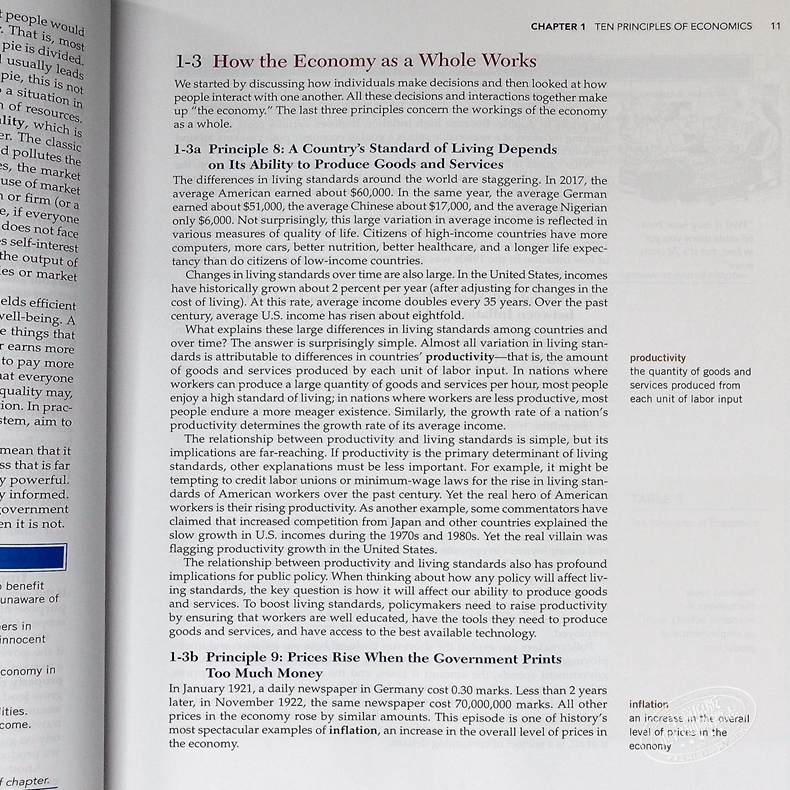

曼昆帶你一覽宏觀經濟學簡史
曼昆的《經濟學原理》是世界上首版(首版出版於1998年)成功的經濟學教科書,自出版後,受到各界好評,克魯格曼高度評價《經濟學原理》是在國際上有影響力的中級教科書之一。
該書已被哈佛大學、耶魯大學、斯坦福大學等美國600餘所大學用作經濟學原理課程的教材,迄今為止它已被翻譯成20種語言在全世界銷售100多萬冊!
書中既包括微觀經濟學中的市場如何運行、市場和福利、公共部門經濟學、企業行為與產業組織、勞動市場經濟學等內容,也包括宏觀經濟學中的宏觀經濟學的數據、長期中的真實經濟、長期中的貨幣與物價、開放經濟的宏觀經濟學、短期經濟波動等內容。本書適合所有高等院校經管等相關專業的師生以及對經濟學感興趣的讀者閲讀。
《經濟學原理》自1999年出版以來一直是國內選用較多、受歡迎的經濟學教材!在繼續保持條理清晰、易於理解的寫作風格基礎上,曼昆教授對全書36章都做了精心修訂;同時也更新了大部分“新聞摘錄”和部分“案例研究”。
這本教科書的特點是它的“學生導向”,如作者自己指出的,他要寫的是一本學生喜歡看的經濟學教科書,與其他同類教科書相比,本書強調得更多的是經濟學原理的應用和政策分析,而不是正式的經濟學模型。為此,作者在大部分章節裏都提供了案例。以説明經濟學原理如何應用於現實經濟問題的分析。此外,作者在書中還提供了大量的“新聞摘錄”,以使讀者懂得什麼是生活中的經濟學。
PRINCIPLES OF ECONOMICS, Seventh Edition, continues to be the most popular and widely-used text in the economics classroom.
A text by a superb writer and economist that stresses the most important concepts without overwhelming students with an excess of detail. A thorough update has been made to keep all chapters fresh and relevant with current Economic coverage.
MindTap, the cutting edge online environment is available with new enhancements that include Graph Builder and Adaptive Test Prep that allow students extra preparation in graph drawing and test review. The seventh edition premier ancillary package is the most extensive in the industry, using a team of instructors/preparers that have been with the project since the first edition.




上帝將宏觀經濟學帶到人間,並不是為了提出和檢驗優美的理論,而是為了解決實際問題。
——N·格雷戈裏·曼昆
書籍目錄
Part I: INTRODUCTION.
1. Ten Principles of Economics.
2. Thinking Like an Economist.
3. Interdependence and the Gains from Trade.
Part II: HOW MARKETS WORK.
4. The Market Forces of Supply and Demand.
5. Elasticity and Its Application.
6. Supply, Demand, and Government Policies.
Part III: MARKETS AND WELFARE.
7. Consumers, Producers, and the Efficiency of Markets.
8. Applications: The Costs of Taxation.
9. Application: International Trade.
Part IV: THE ECONOMICS OF THE PUBLIC SECTOR.
10. Externalities.
11. Public Goods and Common Resources.
12. The Design of the Tax System.Part V: FIRM BEHAVIOR AND THE ORGANIZATION OF INDUSTRY.
13. The Costs of Production.
14. Firms in Competitive Markets.
15. Monopoly.
16. Monopolistic Competition.
17. Oligopoly.
Part VI: THE ECONOMICS OF THE LABOR MARKET.
18. The Markets for the Factors of Production.
19. Earnings and Discrimination.
20. Income Inequality and Poverty.
Part VII: TOPICS FOR FURTHER STUDY.
21. The Theory of Consumer Choice.
22. Frontiers in Microeconomics.
Part VIII: THE DATA OF MACROECONOMICS.
23. Measuring a Nation’s Income.
24. Measuring the Cost of Living.
Part IX: THE REAL ECONOMY IN THE LONG RUN.
25. Production and Growth.
26. Saving, Investment, and the Financial System.
27. Tools of Finance.
28. Unemployment and Its Natural Rate.
Part X: MONEY AND PRICES IN THE LONG RUN.
29. The Monetary System.
30. Money Growth and Inflation.
Part XI: THE MACROECONOMICS OF OPEN ECONOMICS.
31. Open-Economy Macroeconomics: Basic Concepts.
32. A Macroeconomic Theory of the Open Economy.
Part XII: SHORT-RUN ECONOMIC FLUCTUATIONS.
33. Aggregate Demand and Aggregate Supply.
34. The Influence of Monetary and Fiscal Policy on Aggregate Demand.
35. The Short-Run Tradeoff between Inflation and Unemployment.
Part XIII: FINAL THOUGHTS.36. Six Debates over Macroeconomic Policy.





評論曬單